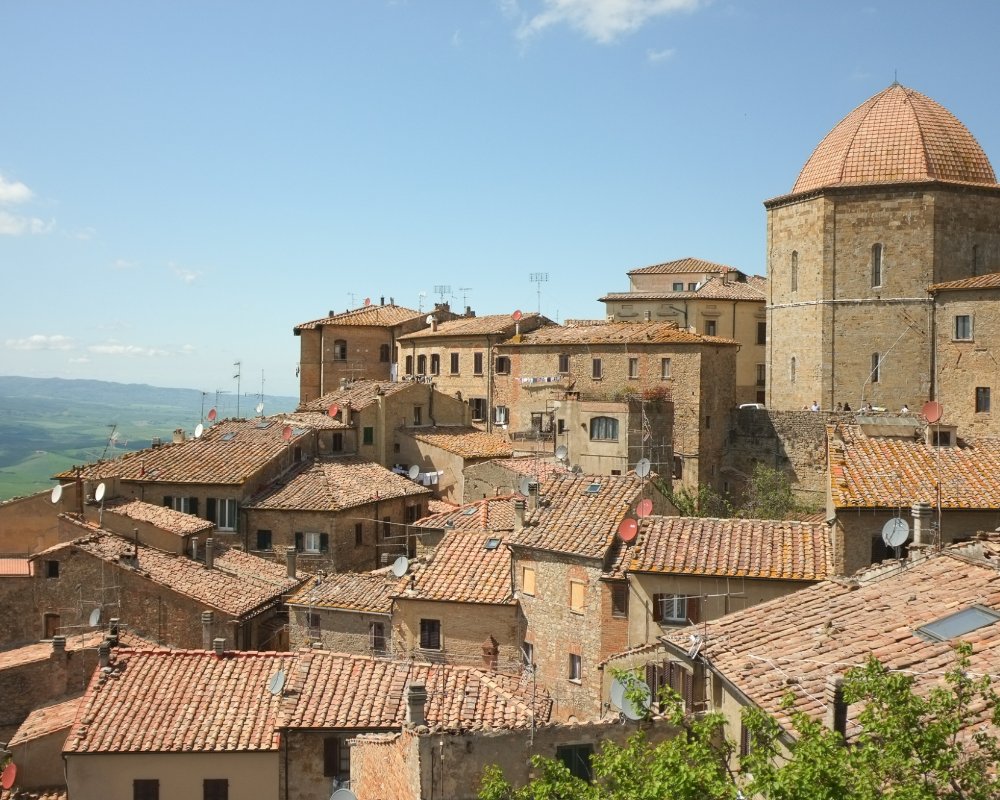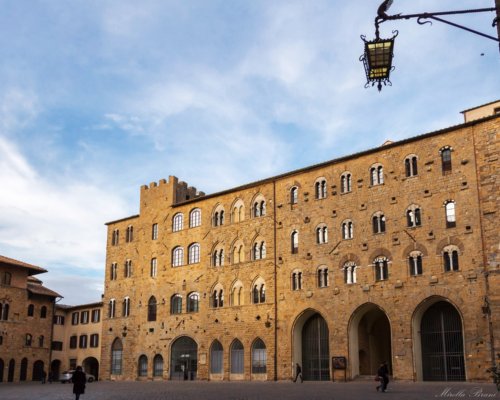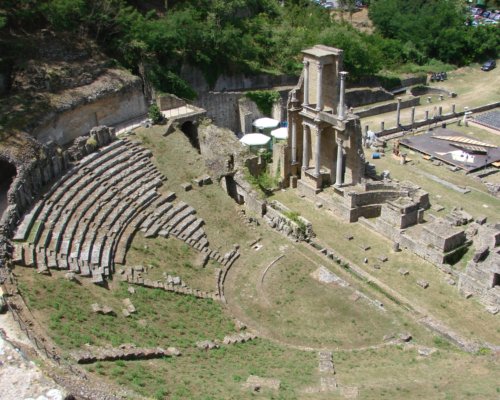An unusual and beautiful journey
Welcome to the Val di Cecina, where in the highlands, the stench of sulphur stains the bright blue air. But don’t be put off by it: taken in its entirety, the territory is rich in natural resources and ripe for exploring, from the hilly backcountry to the sharp ravines dubbed the Balze di Volterra. Its striking scenery follows the course of the Cecina river in the southern portion of the Pisa province, with a dip into the central part of the province of Livorno. For curious weekend travelers, its cultural offerings are as sweeping and varied as its landscape.
The haunting Volterra makes a solid place to hang your hat each night during your Val di Cecina tour. "Twilight" fans will recognize this walled town as the setting of a crucial scene between Bella and Edward.
We recommend roaming the landscape, either by following the path of the “Glampires”, or by starting at the Balze famous cliffs, created by a phenomenon of soil erosion, essentially destroying town’s largest necropolis. The view is wild and arresting, but comes at a price: the erosion has diminished a precious 11th century Camaldolite Abbey, in addition to most of the tombs.
Get back into town and take a look at one of the area’s most precious pieces of heritage, its tradition of alabaster craftsmanship, evident on nearly every street corner as you wind your way through artisan botteghe and appealing shop windows. Dating from as far back as the Etruscan period and extending to the present day, this art form stays rooted in the region in every step, from stone excavation to artistic manipulation and product marketing. Each of these phases is explored in the Alabaster Ecomuseum, housed in the Minucci medieval home and tower.
Wind down your day in Volterra with a leap back in time: just beyond the Porta Fiorentina is one of Italy’s best-preserved Roman theatres, only discovered in the 1950s during excavations. It dates to the Imperial Age but was abandoned at the end of the third century CE. You’ll breathe in history as soon as you set foot here.
The haunting Volterra makes a solid place to hang your hat each night during your Val di Cecina tour. "Twilight" fans will recognize this walled town as the setting of a crucial scene between Bella and Edward.
We recommend roaming the landscape, either by following the path of the “Glampires”, or by starting at the Balze famous cliffs, created by a phenomenon of soil erosion, essentially destroying town’s largest necropolis. The view is wild and arresting, but comes at a price: the erosion has diminished a precious 11th century Camaldolite Abbey, in addition to most of the tombs.
Get back into town and take a look at one of the area’s most precious pieces of heritage, its tradition of alabaster craftsmanship, evident on nearly every street corner as you wind your way through artisan botteghe and appealing shop windows. Dating from as far back as the Etruscan period and extending to the present day, this art form stays rooted in the region in every step, from stone excavation to artistic manipulation and product marketing. Each of these phases is explored in the Alabaster Ecomuseum, housed in the Minucci medieval home and tower.
Wind down your day in Volterra with a leap back in time: just beyond the Porta Fiorentina is one of Italy’s best-preserved Roman theatres, only discovered in the 1950s during excavations. It dates to the Imperial Age but was abandoned at the end of the third century CE. You’ll breathe in history as soon as you set foot here.
To get a sense of the territory, think like a scientist! The Val di Cecina is dense with geothermal productivity, a phenomenon that’s explored in Larderello’s Geothermal Museum. Housed on the ground floor of the Palazzo de’ Larderel - named after the French-Livornese industrialist François Jacques Larderel, a pioneer in the field - this is a one-of-a-kind, multimedia museum. Explore the origins of geothermal energy, learn how drilling and electrical plants work, see the thermal springs or schedule a separate visit to a geyser or a geothermal-electrical plant. Even if science isn’t your forte, the kid-friendly guided tours are family favorites (booking required via museogeotermia@idealcoop.com) and the space makes a solid introduction to the area.
Larderello, after all, is part of the sinister-sounding “Devil’s Valley” - a nickname earned more for its bubbling bodies of water than its (nonexistent) burning condemned! However, the road to hell from here isn’t all that long: Dante Alighieri is believed to have taken inspiration from this landscape for his "Inferno" passages in the "Divine Comedy".
If you have extra time, make the half-hour drive to the always-open Geothermal Natural Park Biancane, found along the Strada Provinciale Bagnolo, a prime place to observe the natural phenomena you will have learned about at the museum.
To get a sense of the territory, think like a scientist! The Val di Cecina is dense with geothermal productivity, a phenomenon that’s explored in Larderello’s Geothermal Museum. Housed on the ground floor of the Palazzo de’ Larderel - named after the French-Livornese industrialist François Jacques Larderel, a pioneer in the field - this is a one-of-a-kind, multimedia museum. Explore the origins of geothermal energy, learn how drilling and electrical plants work, see the thermal springs or schedule a separate visit to a geyser or a geothermal-electrical plant. Even if science isn’t your forte, the kid-friendly guided tours are family favorites (booking required via museogeotermia@idealcoop.com) and the space makes a solid introduction to the area.
Larderello, after all, is part of the sinister-sounding “Devil’s Valley” - a nickname earned more for its bubbling bodies of water than its (nonexistent) burning condemned! However, the road to hell from here isn’t all that long: Dante Alighieri is believed to have taken inspiration from this landscape for his "Inferno" passages in the "Divine Comedy".
If you have extra time, make the half-hour drive to the always-open Geothermal Natural Park Biancane, found along the Strada Provinciale Bagnolo, a prime place to observe the natural phenomena you will have learned about at the museum.
Round out your tour by exploring two of Volterra’s small but scene-stealing surrounding towns: Montecatini Val di Cecina and Montegemoli, both within an easy drive.
The former is famous for its long history of copper mining, which dates back to its early days as an Etruscan settlement. Its Caporciano mine, located about 1 kilometer outside the center of Montecatini Val di Cecina, grew into Europe’s largest mine by the 1800s, before its closure at the turn of the century. The copper-curious can still stop by, as the space has been converted into a museum. Not to be missed is the Alfredo shaft, a key piece of the mining process which reached a depth of 315 meters.
If your interests are more artistic and architectural, stop by the main church of Montecatini Val di Cecina, dedicated to Saint Biagio and built in the 14th century. Curiosities inside include traces of 15th century frescoes painted by an unknown Sienese hand, as well as two terracotta sculptures attributed to the Della Robbia brothers. Local legend says that the Madonna statue opposite the entrance was found in a field below the nearby Camporciano hill.
The tiny Montegemoli, a fraction of Pomarance, is a fun stop for food history fans, as it’s best known for being home to pane di Montegemoli, a famed type of Tuscan bread baked in a wood-fired oven. But its intrigue mostly lies in its neatly preserved medieval character, right down to the former defensive tower of the old castle.
Round out your tour by exploring two of Volterra’s small but scene-stealing surrounding towns: Montecatini Val di Cecina and Montegemoli, both within an easy drive.
The former is famous for its long history of copper mining, which dates back to its early days as an Etruscan settlement. Its Caporciano mine, located about 1 kilometer outside the center of Montecatini Val di Cecina, grew into Europe’s largest mine by the 1800s, before its closure at the turn of the century. The copper-curious can still stop by, as the space has been converted into a museum. Not to be missed is the Alfredo shaft, a key piece of the mining process which reached a depth of 315 meters.
If your interests are more artistic and architectural, stop by the main church of Montecatini Val di Cecina, dedicated to Saint Biagio and built in the 14th century. Curiosities inside include traces of 15th century frescoes painted by an unknown Sienese hand, as well as two terracotta sculptures attributed to the Della Robbia brothers. Local legend says that the Madonna statue opposite the entrance was found in a field below the nearby Camporciano hill.
The tiny Montegemoli, a fraction of Pomarance, is a fun stop for food history fans, as it’s best known for being home to pane di Montegemoli, a famed type of Tuscan bread baked in a wood-fired oven. But its intrigue mostly lies in its neatly preserved medieval character, right down to the former defensive tower of the old castle.


